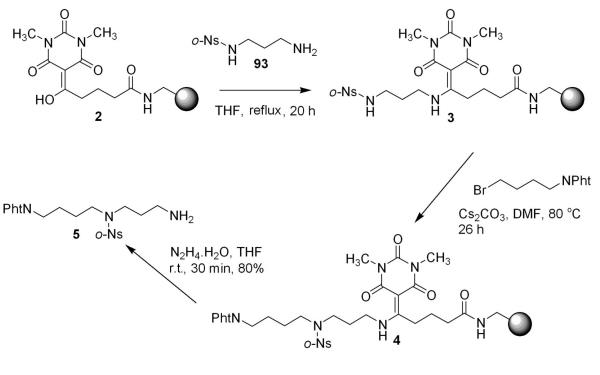4-Azaoctamethylendiamin Chemische Eigenschaften,Einsatz,Produktion Methoden
R-S?tze Betriebsanweisung:
R34:Verursacht Ver?tzungen.
S-S?tze Betriebsanweisung:
S26:Bei Berührung mit den Augen sofort gründlich mit Wasser abspülen und Arzt konsultieren.
S36/37/39:Bei der Arbeit geeignete Schutzkleidung,Schutzhandschuhe und Schutzbrille/Gesichtsschutz tragen.
S45:Bei Unfall oder Unwohlsein sofort Arzt zuziehen (wenn m?glich, dieses Etikett vorzeigen).
S27:Beschmutzte, getr?nkte Kleidung sofort ausziehen.
Beschreibung
Spermidine is an endogenous polyamine. It is formed from putrescine by spermidine synthase.
Chemische Eigenschaften
Spermidine solution is a colorless clear liquid with very hygroscopic and oxidizable. It is soluble in water (50 mg/ml), ethanol, and ether.
Source
Spermidine is found in fresh green pepper, wheat germ, cauliflower, broccoli, mushrooms, and a variety of cheeses. Even higher amounts are found in soybean products such as natto, shitake mushrooms, amaranth grain and durian. Some of these ingredients are particularly common in a Mediterranean diet, which may explain why some believe eating like the Spanish can prolong your life.
Application
Spermidine serves as a precursor of spermine and essential for both normal and neoplastic tissue growth. It was first detected in human sperm, but occurs widely in nature. It is essential in both normal and neoplastic tissue growth. Spermidine has a role in cell growth processes and the formation and interconversion of spermidine in mammalian cells has been reported. It has been studied in the regulation of tRNA methyltransferase activity and stimulates T4 polynucleotide kinase activity.
Definition
ChEBI: Spermidine is a triamine that is the 1,5,10-triaza derivative of decane. It is a polyamine that is routinely included in restriction enzyme digestions to improve the cleavage efficacy of the DNA. Spermidine counteracts the inhibitory effects of contaminants coisolated with DNA and consequently permits complete digestion of the DNA at lower enzyme concentrations.
synthetische
The linker resin 2 was used in the synthesis of spermidine. In order to initiate the preparation the 2-nitrossulfonamide was anchored on the resin 2 by reaction in THF under reflux. The resulting resin 3 then reacted with 4-bromobutylphthalimide in acetonitrile in the presence of Cs2CO3 as base, generating the resin 4. Protected spermidine 5 was cleaved from resin 4 after treatment with hydrate hydrazine at room temperature. Spermidine 5 was previously prepared by our group in solution system utilizing Fukuyama's sulfonamide.

Synthesis and Characterization of a Linker for Primary Amines used in the Solid Phase Organic Synthesis of Spermidine
J. Braz. Chem. Soc., Vol. 22, No. 1, 86-91, 2011
DOI:
10.1590/S0103-50532011000100011
Origin
Spermidine was first discovered in 1678 by Dutch scientist Anton Van Leeuwenhoek in a sample of human semen. Shortly after, spermidine was discovered in human sperm. In the body, spermidine is created from its precursor putrescine.
benefits
The biggest benefit of spermidine is its ability to reduce age-related diseases. It benefits cardioactive, spermidine can reduce the development of atherosclerosis in mice by reducing inflammation and improving cellular (mitochondria) function. It can reduce the formation of blood clots (platelet aggregation) and improve the normal dilation of cells lining blood vessels. Spermidine lowers blood pressure, improves energy use, and reduces heart cell death. It prevents neurologic diseases, and spermidine helps reduce cognitive, memory, and functional impairment associated with aging. It can also Decrease blood sugar levels, Increase autophagy, Increase bone strength, and have Anti-inflammatory effects.
Mode of action
Spermidine's main mechanism of action is its ability to induce autophagy, a self-preservation process which clears out toxic, damaged and dysfunctional cells, resulting in lower levels of inflammation in the body. Autophagy is the main mechanism of spermidine in delaying aging and prolonging the lifespan. In addition, spermidine exerts its effects through other mechanisms, including anti-inflammation, histone acetylation reduction, lipid metabolism and regulation of cell growth and signaling pathways.
Einzelnachweise
Madeo, F., Eisenberg, T., Pietrocola, F., et al. Spermidine in health and disease. Science 359(6374), eaan2788 (2018).
Lopatin, A.N., Makhina, E.N., and Nichols, C.G. Potassium channel block by cytoplasmic polyamines as the mechanism of intrinsic rectification. Nature 372(6504), 366-369 (1994).
Eisenberg, T., Knauer, H., Schauer, A., et al. Induction of autophagy by spermidine promotes longevity. Nat. Cell Biol. 11(11), 1305-1314 (2009).
Guo, X., Harada, C., Namekata, K., et al. Spermidine alleviates severity of murine experimental autoimmune encephalomyelitis. Invest. Ophthalmol. Vis. Sci. 52(5), 2696-2703 (2011).
Eisenberg, T., Abdellatif, M., Schroeder, S., et al. Cardioprotection and lifespan extension by the natural polyamine spermidine. Nat. Med. 22(12), 1428-1438 (2016).
4-Azaoctamethylendiamin Upstream-Materialien And Downstream Produkte
Upstream-Materialien
Downstream Produkte

